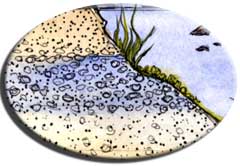Why is groundwater important?
 Water in underground formations where all pore spaces are filled with water is known as groundwater. In many places, groundwater is interconnected with surface water in streams, rivers, and lakes. In some places water flows into surface stream channels from the underlying groundwater supply, while in other places surface water from streams filters through the streambed to replenish the groundwater. Adequate groundwater levels support surface water features such as springs, seeps, cold water pools, and dry-season stream flow. When groundwater levels are lowered due to pumping or water diversions, these surface water features may diminish or even disappear. In addition to groundwater quantity, groundwater quality affects stream health. Cool groundwater is essential for maintaining cold temperatures in pools to support salmon in the summer. Contaminated groundwater may result in contaminated surface water, while the opposite is also true.
Water in underground formations where all pore spaces are filled with water is known as groundwater. In many places, groundwater is interconnected with surface water in streams, rivers, and lakes. In some places water flows into surface stream channels from the underlying groundwater supply, while in other places surface water from streams filters through the streambed to replenish the groundwater. Adequate groundwater levels support surface water features such as springs, seeps, cold water pools, and dry-season stream flow. When groundwater levels are lowered due to pumping or water diversions, these surface water features may diminish or even disappear. In addition to groundwater quantity, groundwater quality affects stream health. Cool groundwater is essential for maintaining cold temperatures in pools to support salmon in the summer. Contaminated groundwater may result in contaminated surface water, while the opposite is also true.
How do we measure groundwater condition?
To assess whether the groundwater is supporting a healthy stream, we can look at the quantity, quality, and fluctuation of flow in a stream. Additionally, we measure groundwater elevations relative to nearby streams to see whether groundwater extractions could cause a stream reach to go dry. We can also measure pollutant concentrations in groundwater.

